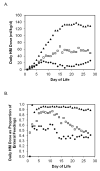Impact of early human milk on sepsis and health-care costs in very low birth weight infants
- PMID: 23370606
- PMCID: PMC3644388
- DOI: 10.1038/jp.2013.2
Impact of early human milk on sepsis and health-care costs in very low birth weight infants
Abstract
Objective: To study the incidence of sepsis and neonatal intensive care unit (NICU) costs as a function of the human milk (HM) dose received during the first 28 days post birth for very low birth weight (VLBW) infants.
Study design: Prospective cohort study of 175 VLBW infants. The average daily dose of HM (ADDHM) was calculated from daily nutritional data for the first 28 days post birth (ADDHM-Days 1-28). Other covariates associated with sepsis were used to create a propensity score, combining multiple risk factors into a single metric.
Result: The mean gestational age and birth weight were 28.1 ± 2.4 weeks and 1087 ± 252 g, respectively. The mean ADDHM-Days 1-28 was 54 ± 39 ml kg(-1) day(-1) (range 0-135). Binary logistic regression analysis controlling for propensity score revealed that increasing ADDHM-Days 1-28 was associated with lower odds of sepsis (odds ratio 0.981, 95% confidence interval 0.967-0.995, P=0.008). Increasing ADDHM-Days 1-28 was associated with significantly lower NICU costs.
Conclusion: A dose-response relationship was demonstrated between ADDHM-Days 1-28 and a reduction in the odds of sepsis and associated NICU costs after controlling for propensity score. For every HM dose increase of 10 ml kg(-1) day(-1), the odds of sepsis decreased by 19%. NICU costs were lowest in the VLBW infants who received the highest ADDHM-Days 1-28.
Figures



Comment in
-
Human milk dose in the first month is inversely associated with sepsis and NICU costs.J Hum Lact. 2013 Aug;29(3):339-40. doi: 10.1177/0890334413492653. J Hum Lact. 2013. PMID: 23855031 No abstract available.
References
-
- Fanaroff AA, Stoll BJ, Wright LL, Carlo WA, Ehrenkranz RA, Stark AR, et al. Trends in neonatal morbidity and mortality for very low birthweight infants. Am J Obstet Gynecol. 2007;196:147.e1–147.e8. - PubMed
-
- Stoll BJ, Hansen NI, Adams-Chapman I, Fanaroff AA, Hintz SR, Vohr B, et al. Neurodevelopmental and growth impairment among extremely low-birth-weight infants with neonatal infection. JAMA. 2004;292:2357–2365. - PubMed
-
- Payne NR, Carpenter JH, Badger GJ, Horbar JD, Rogowski J. Marginal increase in cost and excess length of stay associated with nosocomial bloodstream infections in surviving very low birth weight infants. Pediatrics. 2004;114:348–355. - PubMed
Publication types
MeSH terms
Grants and funding
LinkOut - more resources
Full Text Sources
Other Literature Sources
Medical

